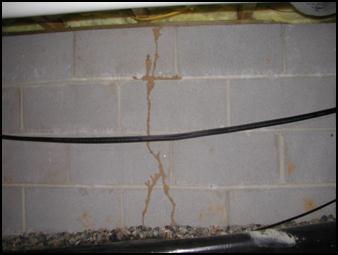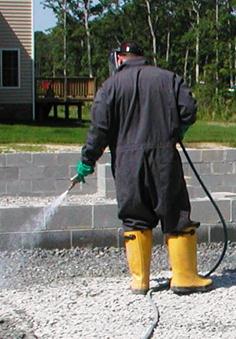For Builders: Pre-Construction Termite Treatments
One of the most destructive insects to homes and other buildings in Virginia is the subterranean termite. A report by the National Pest Management Association estimates that termites have caused $5 billion in property damage nationwide. According to the Termite Infestation Probability Map developed by the US Forestry Service, Virginia falls in the Moderate to Heavy Zone for termite infestations. This means that regardless of where a home is located in the state, there is a strong probability for a termite infestation. If a home or structure is not treated correctly or if a treatment is disturbed, it does not take long for termites start their “attack” on the home. As their name implies, subterranean termites live below ground. They build shelter tubes or tunnels in areas such as crawlspaces, masonry voids or directly into wood contacting soil. Quite often termites and their damage goes unnoticed for long periods of time because these areas are hidden and either difficult or impossible to inspect. Because of this, the best time to protect a building from future termite damage is during construction especially if chemicals are used. The applicator will have access to areas of the structure at that time which would be inaccessible once construction is complete.

Although builders do not apply pesticides to the buildings that they are constructing, they do play a key role in making sure that they are protected from future insect damage. Their role begins when they select a pest management firm to perform the pre-construction termite treatment and ends when they turn it over to the purchaser. A good builder will actively work with the pest management firm to make sure the job is done according to the pesticide label requirements. In order to do that, the builder must first select a reputable company that holds a valid Virginia pesticide business license.
A company’s reputation can be determined to some extent by how they bid on the job. Builders should get several bids for a job then compare them. Do not hire a company just because they offer the lowest price! This may seem to make sense economically, but the old adage that “you get what you pay for” is still true even when it comes to termite treatments. If cost alone is the criteria for selecting a business, it is likely the structure will not be treated correctly. A business that provides a bid that is substantially lower than their competitors may not provide a proper and complete treatment. The presentation, The Cost of Preconstruction Liquid Termiticide Treatment, explains how termite treatment costs are calculated. This presentation was developed by Dr. Dini Miller, an entomologist at Virginia Tech.
The Office of Pesticide Services has investigated some businesses and found that they cut costs in one of the following manners.
- An employee dilutes the pesticide to a lower concentration. For example, instead of mixing 1 gallon of concentrate with 100 gallons of water, an employee might mix ½ gallon to 100 gallons. This practice makes the pesticide weaker thereby reducing its effectiveness.
- An employee applies lower amounts of pesticide by reducing the quantity applied. For example, a label requires application to soil along the foundation at the rate of 4 gallons per 10 linear feet per foot of depth. Calculations determine 200 gallons is required for a specific site, but the business only applies 50 gallons. Again, this reduction in pesticide will result in an ineffective treatment that will not protect the home in the manner intended.
- A business skips certain phases of the preconstruction treatment. Example: A company may never return to apply the final perimeter treatment to soil that was placed along the foundation. Untreated soils create a bridge for termites to “attack” the structure.
If a painter were to use any of these tactics when painting a home the quality of their work would be obvious. Plaster patches would be visible through the paint. Streaks would appear on painted surfaces. Knots would stand out in wooden elements. The builder and homeowner would not tolerate this type of work. They would make the painter return and complete the job as contracted. Because the termite treatment is less visible, it is harder to determine whether it was done correctly. In order to prevent this type of work from occurring, the builder needs to be familiar with some basic termite treatment requirements to help them determine whether a company is treating a home properly. To learn more read the Proper Application of Preconstruction Termite Treatments section of this website. This section provides basic information about preconstruction termite treatments and gives examples of how two different types of homes are treated. It also has a Pretreat Checklist for builders. You can also download the brochure with the same title here.
In addition to soil applied termiticides, there are other options for termite prevention and control on new and existing homes. These include termite baiting systems and wood applied termiticides such as borates. The publication Subterranean Termite Treatment Options from the Virginia Cooperative Extension discusses soil applied termiticides and baiting systems as well as the advantages and disadvantages of each type of treatment. Another resource which may be of interest is the publication titled Termite Prevention-Approaches for New Construction from the North Carolina Cooperative Extension.
The Virginia Department of Agriculture and Consumer Services has developed a resource for builders and homeowners that they can use when researching a business. The Civil Penalty Searchable Database lists businesses which have been assessed penalties under §3.2-3943 of the Virginia Pesticide Control Act during the past three years. In using this tool, builders and homeowners must understand that even reputable companies may have occasional violations. It is also possible, that a business may not be listed because it has never been “caught” performing illegal applications. Builders and homeowners may also contact their local Better Business Bureau to find out if there have been any complaints related to a business. While these resources serve as tools, the best ways to determine whether you should hire a business is to get references from people you trust and to ask the business questions about how they plan to perform the treatment.
Tips for making sure a company performs proper Pretreat applications.

- Find out what pesticide is being used and obtain a copy of the label. If the business does not provide a copy, ask for the product name and EPA Registration Number. You can use these to find a copy of the label either online or by contacting the Office of Pesticide Services.
- Randomly observe the pest management company while they perform termite treatments.
- Prior to their arrival, calculate how much termiticide should be used based on the pesticide label. Compare the quantity they apply to your own calculations. If there is a variation, ask them to explain it based on the label.
- Ask the company to open the unsealed container and mix the termiticide while you’re observing them (in some cases they may have a partial container from a previous job which is okay).
Requirements for termite protection or treatments of structures are found in the Virginia Uniform Statewide Building Code. The state code is based on the International Building Code. Termite prevention is discussed in Chapter 3 of the Virginia Residential Code. Protection of wood against decay and termites is also addressed in Chapter 23, Section 2304.11, of the Virginia Construction Code. If a pesticide is used then the pesticide business must apply it according to its label. For questions related to the requirements of the Virginia Uniform Statewide Building Code contact your local building code official.
When loans are issued under FHA or VA programs for new construction, the U.S. Department of Housing and Urban Development (HUD) requires that a treatment method meet their minimum property standards. They recognize that properties which comply with the International Residential Code satisfy these requirements.
HUD requires that the builder provide a Subterranean Termite Protection Builder’s Guarantee (HUD-NPCA-99-A) to lenders granting mortgages under FHA or VA programs. This form documents the type of termite treatment or prevention technique used on a site. When a builder signs this form, they certify that the “contract with the pest control company required the treatment materials and methods used to be in conformance with all applicable State and Federal requirements.” They also certify that “all work has been completed unless noted on HUD-NPMA 99B.” If a pest control company does not apply a pesticide in accordance with the product’s label then they are in violation with both State and Federal laws and regulations. Although the builder relies upon the pest control company to provide information related to the treatment, he does have some responsibility in making sure the work is completed in accordance with the pesticide label. Both the HUD-NPCA-99-A form and the related New Construction Subterranean Termite Service Record (HUD-NPCA-99-B) state “Warning: HUD will prosecute false claims and statements. Conviction may result in criminal and/or civil penalties. (18 U.S.C. 1001, 1012; 31 U.S.C. 3729, 3802).” If a builder is knowledgeable that a treatment was not performed in conformance with all applicable State and Federal requirements, he could be prosecuted by HUD.
The HUD-NPCA-99-B provides specific information about the treatment such as the brand name of the termiticide used, the EPA Registration Number, total gallons of liquid termiticide (if applicable) and the termiticide dilution or number of bait stations. When a pesticide business signs the HUD-NPCA-B they are affirming that “The applicator has used a product has used a product in accordance with the product label and state requirements…”
Although pesticide businesses are required to maintain records of pesticide applications neither the Virginia Pesticide Control Act (Act) or the Regulations grant authority to the Board of Agriculture and Consumer Services or the Office of Pesticide Services to regulate termite treatment contracts, warranties or agreements. The Act addresses certification of applicators, licensing of pesticide businesses, and the registration and use of pesticides. Disputes related to termite contracts, warranties or agreements should be directed to the Consumer Protection Section of the Office of the Attorney General (OAG). The Consumer Protection Section can be contacted by phone at 800-552-9963 (Toll Free) or (804) 786-2042 (Richmond area). Consumers may also fill out an online complaint form by clicking here.
If you suspect that a pest management firm has performed an improper preconstruction termite treatment, you can contact the Office of Pesticide Services. The Enforcement and Compliance Staff can assist builders and homeowners by conducting in-depth investigations to determine if a pesticide was misused. To learn more about the complaint process read “Complaints Related to the Misapplication of a Pesticide”.
References & Sources:
The Cost of Preconstruction Liquid Termiticide Treatment
Proper Application of Preconstruction Termite Treatments (VDACS)
The Big Bite of Termites: $5 Billion A Year in Damages (NPMA)
VBCOA Virginia Uniform Statewide Building Code –The Virginia Building Code Officials Association provides links to various state codes. Termite prevention is discussed in Chapter 3 of the Virginia Residential Code. Protection of wood against decay and termites is also addressed in Chapter 23, Section 2304.11, of the Virginia Construction Code.